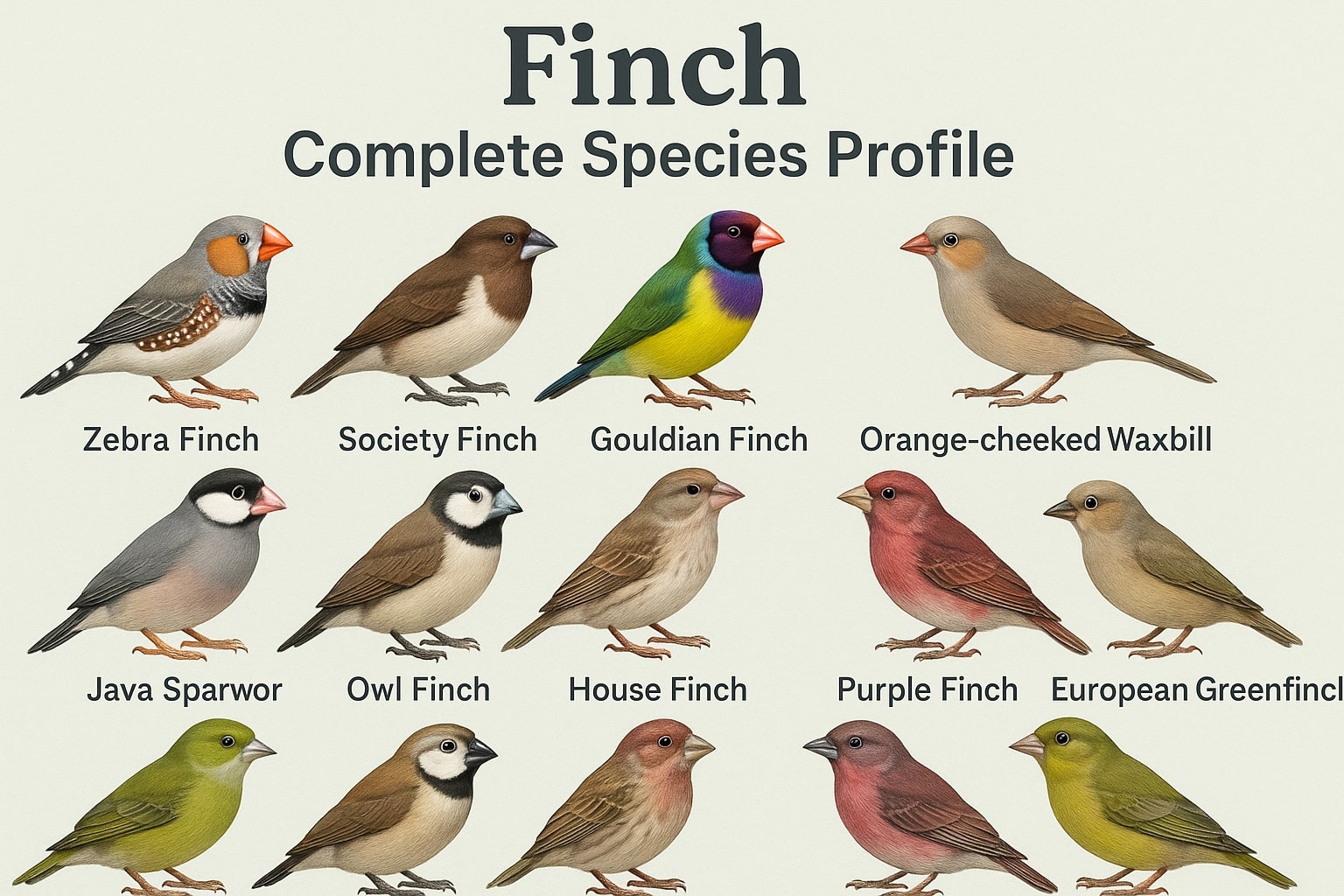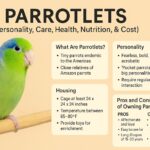Small, colorful, and melodious, finches represent one of the most diverse and successful groups of songbirds on our planet. These remarkable birds have captured human attention for centuries with their vibrant plumage, sweet songs, and incredible adaptability.
From the familiar goldfinch visiting backyard feeders to the famous Darwin’s finches that helped shape our understanding of evolution, these birds showcase nature’s creativity in its finest form.
The world of finches encompasses hundreds of species spread across multiple families, each with unique characteristics that have allowed them to thrive in environments ranging from arctic tundra to tropical rainforests.
Understanding True Finches: The Fringillidae Family
The true finches belong to the family Fringillidae, a group that contains more than two hundred species divided into fifty genera. These small to medium-sized passerine birds share several distinctive characteristics that set them apart from other songbirds.
Most notably, finches possess stout conical bills specifically adapted for eating seeds and nuts, and many species display colorful plumage that makes them favorites among birdwatchers and pet enthusiasts alike1.
The Fringillidae family includes familiar birds such as canaries, siskins, redpolls, serins, grosbeaks, and euphonias. Perhaps most surprisingly, this family also encompasses the morphologically diverse Hawaiian honeycreepers, which demonstrate how dramatically finches can evolve when presented with new ecological opportunities. These birds occupy a tremendous range of habitats where they typically remain as permanent residents rather than migrating seasonally.
The naming conventions around finches can create confusion because many birds in other families also carry the “finch” designation. The estrildid finches of the Old World tropics and Australia belong to the Estrildidae family, while some members of the bunting family (Emberizidae) and New World sparrow family (Passerellidae) also bear finch names.
Most famously, Darwin’s finches from the Galapagos Islands are now classified as members of the tanager family (Thraupidae) rather than true finches.
Physical Characteristics and Identification
True finches display remarkable variation in size despite their generally compact build. The smallest species include the Andean siskin, measuring just 9.5 centimeters in length, and the lesser goldfinch, weighing as little as 8 grams.
At the opposite extreme, the collared grosbeak can reach 24 centimeters and weigh up to 83 grams, while the evening grosbeak has been recorded at weights up to 86.1 grams.
All true finches share certain anatomical features that help with identification. They possess nine primary remiges (flight feathers) and twelve rectrices (tail feathers). Their beaks represent their most distinctive feature, ranging from small and pointed to large and robust, depending on their preferred food sources.
Hawaiian honeycreepers showcase the most extreme beak diversity, having evolved an impressive array of bill shapes and sizes through adaptive radiation.
Plumage coloration in finches follows interesting patterns. The basic color scheme tends toward brownish or greenish tones, often accented with considerable amounts of black. White plumage remains generally absent except for wing bars or other signaling marks.
Bright yellow and red carotenoid pigments appear commonly throughout the family, which explains why blue structural colors remain relatively rare – the yellow pigments interact with blue to create green coloration instead.
Sexual dimorphism varies significantly among finch species. Many, though not all, display strong differences between males and females, with females typically lacking the bright carotenoid markings that make males so visually striking. This difference becomes particularly pronounced during the breeding season when males use their colorful plumage to attract mates and establish territories.
Global Distribution and Habitat Preferences
Finches achieve a near-global distribution that spans the Americas, Eurasia, and Africa, along with various island groups, including the Hawaiian Islands. However, they remain notably absent from Australasia, Antarctica, the Southern Pacific, and the islands of the Indian Ocean, though European species have been widely introduced in Australia and New Zealand.
These adaptable birds occupy an impressive range of habitats. While finches typically prefer well-wooded areas, many species have successfully colonized mountains and even desert environments. This habitat flexibility has contributed significantly to their evolutionary success and widespread distribution.
In North America, the house finch provides an excellent example of habitat adaptability. In their native western range, house finches inhabit natural environments including dry desert, desert grassland, chaparral, oak savannah, streamsides, and open coniferous forests at elevations below 6,000 feet. However, they have also become remarkably successful in human-modified landscapes, thriving around buildings, lawns, small conifers, and urban centers.
The house finch’s range expansion tells a fascinating story of both intentional and accidental human influence. Originally native to the western United States, from Oregon and Idaho south to Mexico, house finches were introduced to Long Island, New York, in the 1940s.
After initially struggling to establish themselves, the population eventually took hold and spread throughout the eastern United States, reaching from southern Canada to the Gulf of Mexico and west to the Mississippi River.
Feeding Behavior and Diet
Finches are primarily granivorous, meaning they feed mainly on seeds and grains. This dietary preference explains their robust, conical beaks, which function as efficient seed-cracking tools. However, the family shows considerable dietary diversity beyond basic seed consumption.
Euphoniines include substantial amounts of arthropods and berries in their diet, while Hawaiian honeycreepers have evolved to utilize an incredible range of food sources, including nectar.
House finches exemplify the typical finch diet, eating almost exclusively plant materials including seeds, buds, and fruits. Their wild food preferences include wild mustard seeds, knotweed, thistle, mulberry, poison oak, cactus, and many other plant species.
In agricultural areas, they consume cherries, apricots, peaches, pears, plums, strawberries, blackberries, and figs. At bird feeders, they show a clear preference for black oil sunflower seeds over larger striped sunflower seeds, along with millet and milo.
Young finches require additional nutrition during their rapid growth phase. Fringillidae nestlings receive varying amounts of small arthropods in their diet, providing essential proteins for proper development. This dietary supplementation demonstrates the flexibility that has made finches so successful across diverse environments.
Social Behavior and Flight Patterns
Finches exhibit highly social behavior outside of breeding season. House finches, for example, are rarely seen alone except during breeding, and may form flocks containing several hundred birds. This gregarious nature provides advantages, including increased foraging efficiency and enhanced predator detection.
True finches display a characteristic bouncing flight pattern typical of many small passerines. This flight style alternates between periods of active flapping and gliding on closed wings. The bouncing motion results from the birds gaining altitude during flapping phases and losing altitude during gliding phases, creating the distinctive undulating flight path that helps with species identification.
Most finch species are accomplished singers, and several have become popular cagebirds primarily due to their vocal abilities. The domesticated canary (Serinus canaria domestica) represents the most famous example of finch song appreciation, having been selectively bred for centuries to enhance their musical capabilities.
Nesting and Reproduction
Finches construct basket-shaped nests usually built in trees, though some species choose bushes, rock crevices, or similar substrates. House finches demonstrate typical finch nesting behavior while also showing remarkable adaptability to human environments.
They nest in various deciduous and coniferous trees as well as on cactus and rock ledges. Additionally, they readily utilize human structures, building nests in or on buildings using sites like vents, ledges, street lamps, ivy, and hanging planters.
House finch nests consist of cups made from fine stems, leaves, rootlets, thin twigs, string, wool, and feathers, with similar but finer materials lining the interior. These nests typically measure 3-7 inches in overall width, with interior cups spanning 1-3 inches across and reaching depths up to 2 inches.
Reproductive success varies among finch species, but house finches provide detailed examples of typical breeding patterns. Females lay clutches of 2-6 eggs that are pale blue to white and speckled with fine black and pale purple markings.
The incubation period lasts 13-14 days, followed by a nestling period of 12-19 days. House finches can produce 1-6 broods per year, demonstrating their reproductive efficiency.
Darwin’s Finches: A Special Case Study
No discussion of finches would be complete without examining Darwin’s finches, though these birds represent a fascinating case of convergent evolution rather than true finch relationships. Darwin’s finches, also known as Galápagos finches, comprise approximately 18 species of passerine birds that belong to the tanager family rather than true finches. Their closest known relative is the South American dull-colored grassquit.
These remarkable birds gained fame as a classic example of adaptive radiation and for their extraordinary diversity in beak form and function. They vary in size from 10 to 20 centimeters and weigh between 8 and 38 grams.
The smallest are the warbler-finches, while the largest is the vegetarian finch. The most significant differences between species appear in the size and shape of their beaks, which have become highly adapted to different food sources.
Darwin’s finches fall into four main categories based on their genera: Geospiza, Camarhynchus, Certhidea, and Pinaroloxias. The Geospiza genus includes ground finches and cactus finches, while Camarhynchus encompasses tree finches, woodpecker finches, and mangrove finches. The Certhidea and Pinaroloxias groups contain single species each: the warbler finch and the Cocos Island finch, respectively.
Human Relationships and Cultural Significance
Finches have maintained significant relationships with humans throughout history. Most famously, finches and canaries served crucial safety roles in the coal mining industry across the UK, US, and Canada from the eighteenth to the twentieth centuries.
These small birds were used to detect carbon monoxide gas, as their high metabolic rates made them early indicators of dangerous gas concentrations. This practice continued in the UK until 1986.
Today, finches provide various benefits to human communities. Some species, particularly canaries, remain popular as cage birds, prized for their beauty, behavior, and song. As seed-eaters, many finch species provide valuable weed control services, while some may offer limited assistance in controlling insect populations.
Ecologically, finches serve important roles in food webs, being consumed by owls and other predators, while some species contribute to seed dispersal.
The house finch exemplifies both positive and challenging aspects of human-finch relationships. While many people enjoy these birds at backyard feeders, their expansion into agricultural areas has created conflicts with fruit growers.
Their preference for soft fruits can result in significant crop damage, leading to management challenges in commercial orchards.
Conservation and Future Outlook
Most finch species currently maintain stable populations, though some face localized threats from habitat loss, climate change, and human development. The remarkable adaptability that has made finches so successful provides hope for their continued survival in changing environments.
However, specialized species like some Hawaiian honeycreepers face greater conservation challenges due to their narrow ecological requirements and limited distributions.
Understanding finch ecology and behavior remains important for both conservation efforts and human enjoyment of these remarkable birds. Their success across diverse habitats demonstrates the power of evolutionary adaptation, while their relationships with humans highlight both the benefits and challenges of coexistence with wildlife.
Finches continue to serve as valuable subjects for scientific research, particularly in areas of evolution, behavior, and ecology. Their diverse beak morphologies, feeding strategies, and habitat preferences provide insights into how species adapt to environmental challenges.
As we face ongoing environmental changes, finches may well serve as indicators of ecosystem health and resilience, making their continued study and conservation increasingly important for understanding our changing world.
Conclusion
Finches are truly fascinating birds that showcase the incredible diversity and adaptability found in nature. From their distinctive seed-cracking beaks to their vibrant plumage and complex social behaviors, finches have successfully colonized a wide range of habitats across the globe. Their ability to thrive in both wild and urban environments speaks to their resilience and ecological importance.
The story of Darwin’s finches adds a unique chapter to their legacy, illustrating how small changes in physical traits like beak shape can drive the evolution of new species. Meanwhile, species like the house finch demonstrate how finches continue to interact closely with human environments, sometimes bringing both joy and challenges.
Conservation efforts remain crucial for protecting specialized finch species that face habitat loss and other threats. By studying finches, scientists gain valuable insights into evolution, ecology, and the impacts of environmental change. For bird lovers and researchers alike, finches offer endless opportunities to appreciate the beauty and complexity of the natural world.
- 9 Types of Lovebirds (A Comprehensive Guide for Pet Bird Owners) - June 20, 2025
- Labrador Retriever: America’s Most Beloved Family Dog - June 9, 2025
- The Complete Guide to Indian Ringneck Parrots - June 9, 2025















